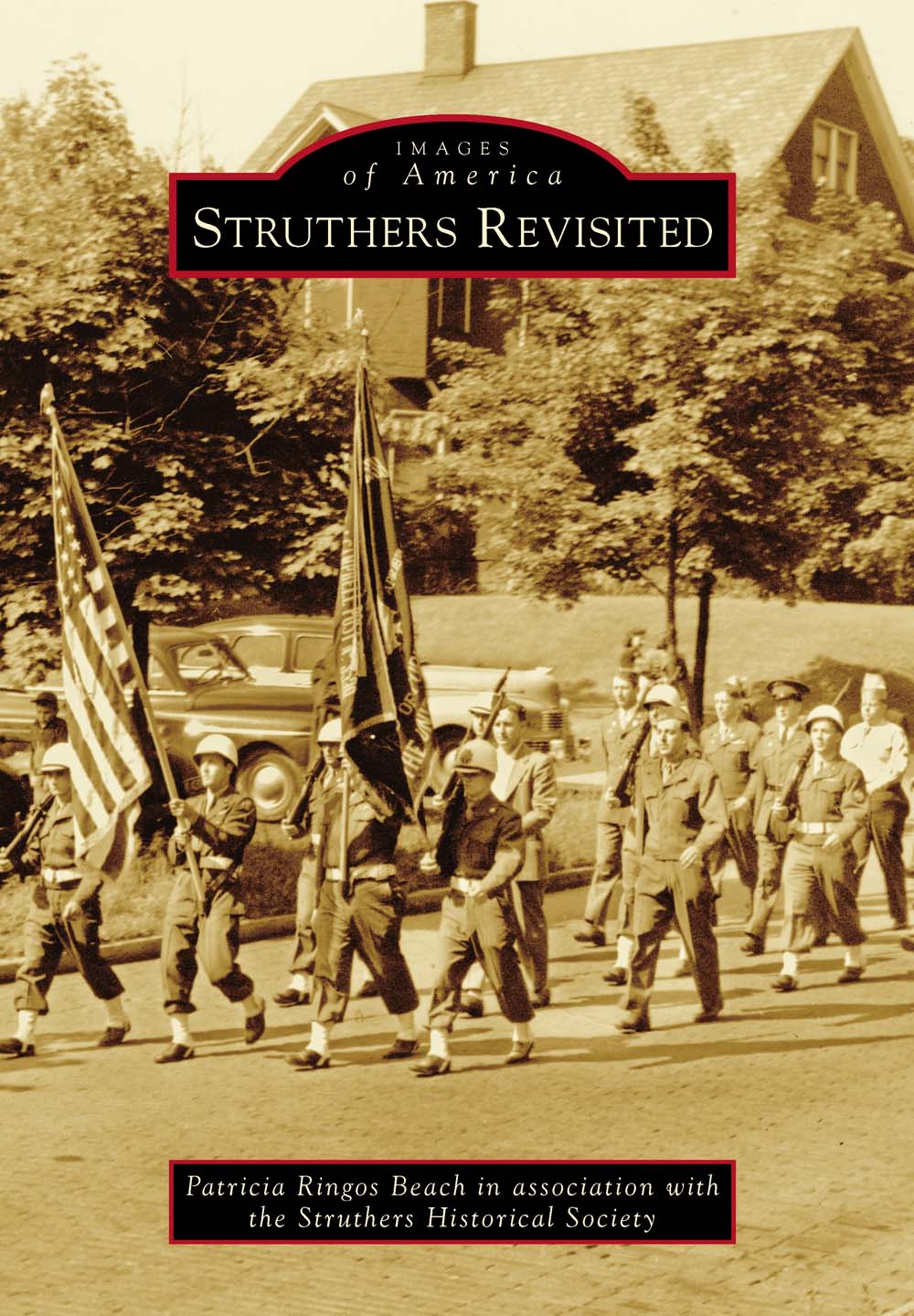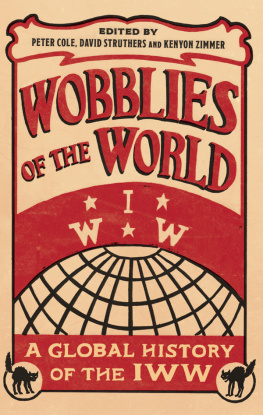
IMAGES
of America
STRUTHERS REVISITED

Welcome to Struthers, the city with heart in the heart of it all. (Courtesy of Frank Marr.)
ON THE COVER: In this 1948 photograph, members of the Struthers Veterans of Foreign Wars Post No. 3538 march along Poland Avenue. Carrying flags, they lead the homecoming parade welcoming back veterans who served in World War II and remembering those who died while serving. (Courtesy of the Struthers Historical Society.)
IMAGES
of America
STRUTHERS REVISITED
Patricia Ringos Beach in association with
the Struthers Historical Society

Copyright 2015 by Patricia Ringos Beach
ISBN 978-1-4671-1356-4
Ebook ISBN 9781439651087
Published by Arcadia Publishing
Charleston, South Carolina
Library of Congress Control Number: 2015933212
For all general information, please contact Arcadia Publishing:
Telephone 843-853-2070
Fax 843-853-0044
E-mail
For customer service and orders:
Toll-Free 1-888-313-2665
Visit us on the Internet at www.arcadiapublishing.com
This book is dedicated to 286 Hopewell Drive, the house that built me.
CONTENTS
ACKNOWLEDGMENTS
When you talk, you are only repeating what you already know; but when you listen, you may learn something new.
Dalai Lama.
As I complete Struthers Revisited, I am reminded that it takes a village to write a book. A thank-you is owed to the Struthers Historical Society. The care that you take of the history of our town is equaled only by your generosity in sharing it. In particular, Marian Kutlesa, thank you. Unless otherwise noted, all photographs are from the societys collection.
The support I received as the book developed was an incredible gift to me. Pat Bundy, Denise Collingwood, Dominick Commisso, Dick Dale, Marian Kutlesa, Frank Marr, Gary Mudryk, and Debbie Zetts never allowed a question or request to go unanswered.
Struthers Revisited went through several drafts thanks to extraordinarily generous readers. Thanks go to Pat Bundy, Michael Buchenic III, Denise Collingwood, Dick Dale, Cynthia Ringos Donahue, Paula Ringos Drapcho, Laddie Fedor, Marian Kutlesa, Dan Mamula, Sue Pitcher, and Emmalee Torisk.
To everyone on these pages representing Struthers, thank you. In many cases someone took the time to search through old family photographs and share stories. For the time they took to help, I want to acknowledge Julia Amicone, Dan Becker, Martha Bishop, Anne and Teresa Boano, Kathy Brantley, Christine Roskos Cavalier, Annette Todeska Ciccoelli, J.P. Daliman, Roger Day, Betty Kossick DeCesare, Gil Frank, John Gingery, Nancy Johngrass, John Kerlek, Marianne Daliman Kieffer, Nancy Tobias Knight, Bob Komara, Robert Kurtz, Dan Mamula, Ed Marsh, Doris Matricardi, Harold and Linda Milligan, Sue Missik, John Morell Jr., Janet Morris, Bill OHara, Jeff Pantall, Joe Paris, Judy Kurtz Sabula, Dennis Smith, Terry Stocker, Debbie Volsko, Esther Watts, Gregg Wormley, Gene and Rose Yuhas, and William Zaluski.
A thank-you is given to Jesse Darland, my title manager at Arcadia Publishing, whose assistance proved invaluable.
This book is intended to add to the history documented in Struthers (2008) and not be repetitious. I apologize in advance for any errors and regret that there are photographs and stories that, because of the constraints of space, could not be in this book.
Finally, thank you to my husband, Dan, for your patient and constant love and support.
INTRODUCTION
The city with heart in the heart of it all. The Struthers motto is deceptively simple. It encourages and supports while progressing forward and embracing changeit is familiar and uncomfortable. Perhaps no other century depicts this better than the 20th century. It was a time of change.
In the early 1900s, instant coffee, tea bags, Vicks VapoRub, and Jell-O came to market. The electric washing machine and electric toaster were invented. The bicycle was a cheap form of transportation, and automobiles were a fantasy for most Americans. The city of Struthers was then known as Marbletown. Only after Thomas Struthers bought back the family homestead to honor his father and brought railroads and industry to town, sometime around 1903, was the town name changed to Struthers by popular vote. In 1900, Youngstown Iron Sheet and Tube Company was established.
In the 1910s, the worlds largest and most luxurious ship, Titanic, hit an iceberg on its maiden voyage from Southampton, England, to New York City just before midnight on April 14, 1912, and more than 1,500 people died in the frigid Atlantic Ocean in the worst maritime accident ever. In 1919, Congress passed the 18th Amendment making the manufacture, sale, or transport of intoxicating liquors illegal. Struthers enforced Prohibition, but when it ended in 1933, it issued Rips Restaurant the first liquor license.
In the 1920s, the stock market crash in 1929 devastated economies around the world, leading to the Great Depression. Banks collapsed, and about a quarter of the American workforce could not find jobs. Not being able to get money from the banks to buy your children shoes also hit Struthers. Many local businesses, like Begalass Grocery Store and Milligans Dairy, helped families in need.
In the 1930s, Disney introduced its first animated motion picture, Snow White and the Seven Dwarfs (1937). Although records are lost, it probably played at the Ritz Theatre in downtown Struthers. Germany invaded Poland in 1939, setting the stage for World War II. Lou Gehrig, the Pride of the Yankees, retired July 4, 1939, having played in 2,130 games over 15 seasons as a Yankee first baseman; he died of amyotrophic lateral sclerosis (ALS), today also known as Lou Gehrigs Disease, in 1941.
In the 1940s, Warner Brothers introduced animated characters Elmer Fudd, Bugs Bunny, Daffy Duck, Porky Pig, Sylvester, and the Road Runner to television. December 7, 1941, the Japanese attacked Pearl Harbor, drawing the United States into World War II. On June 6, 1944, D-Day, 300,000 Allied troops landed on the beaches of Normandy, France, re-entering continental Europe and taking a big step toward ending the war. Many young lives from Struthers were lost in the wars of the 20th century.
In the 1950s, on Thanksgiving Day 1950, snow started falling in Struthers, and over two days, it developed into one of the towns worst blizzards. I Love Lucy premiered in 1951 and was the number one comedy show within six months. NBC offered regular color television programming in 1953. Dick Clark premiered American Bandstand, and Elvis Presley entered the rock-and-roll scene in 1956. The hula-hoop was introduced in 1958, and the Barbie doll by Mattel Toys in 1959. North Korea invaded South Korea on June 25, 1950, and 54,000 Americans died before the peace treaty was signed July 27, 1953. Dr. Jonas Salk licensed a vaccine against polio in 1955. Alaska became the 49th state on January 3, 1959, and Hawaii the 50th state on June 27, 1959.
In the 1960s, Harper Lee wrote To Kill a Mockingbird (1960) and won the 1961 Pulitzer Prize for Fiction. In the 1960 election, presidential debates were televised for the first time. The young Democrat, John F. Kennedy, defeated Richard Nixon in both the debates and the election. Lee Harvey Oswald assassinated him on November 22, 1963, in Dallas, Texas. The Beatles from Liverpool, England, appeared on
Next page











